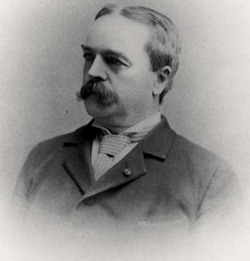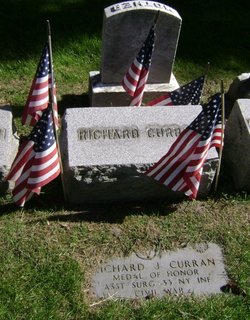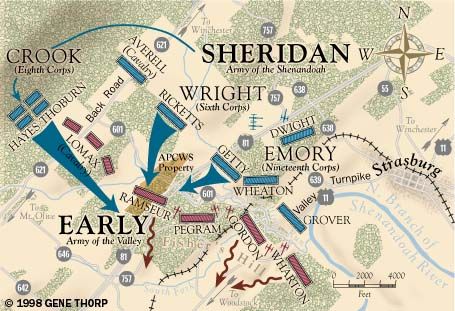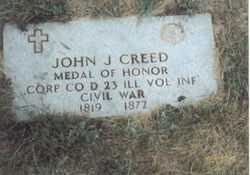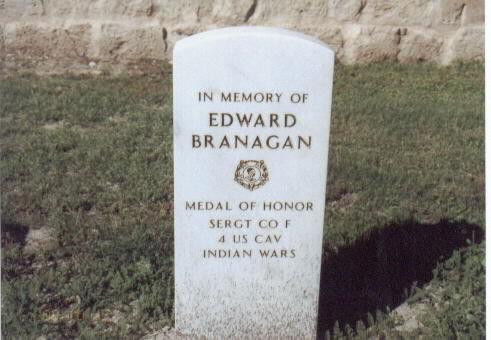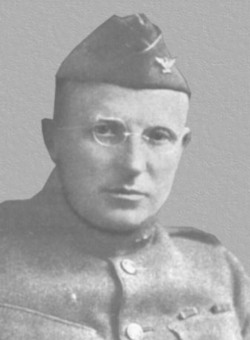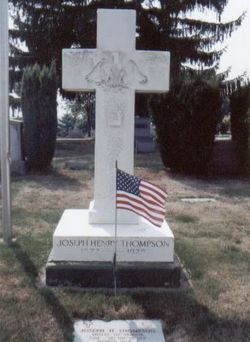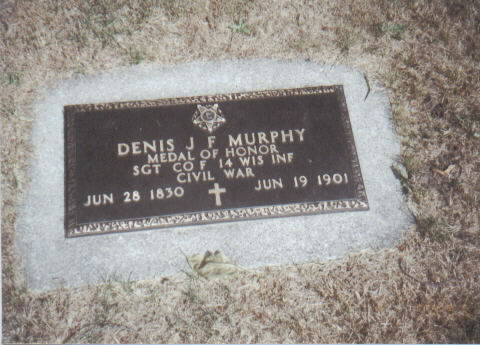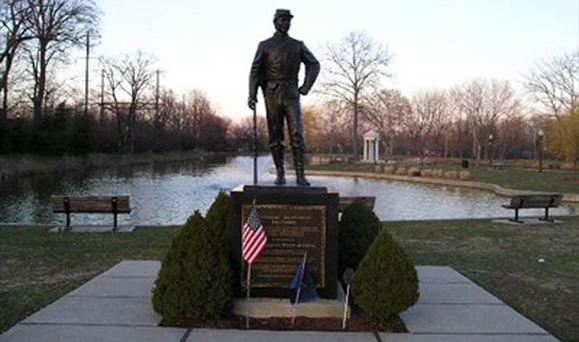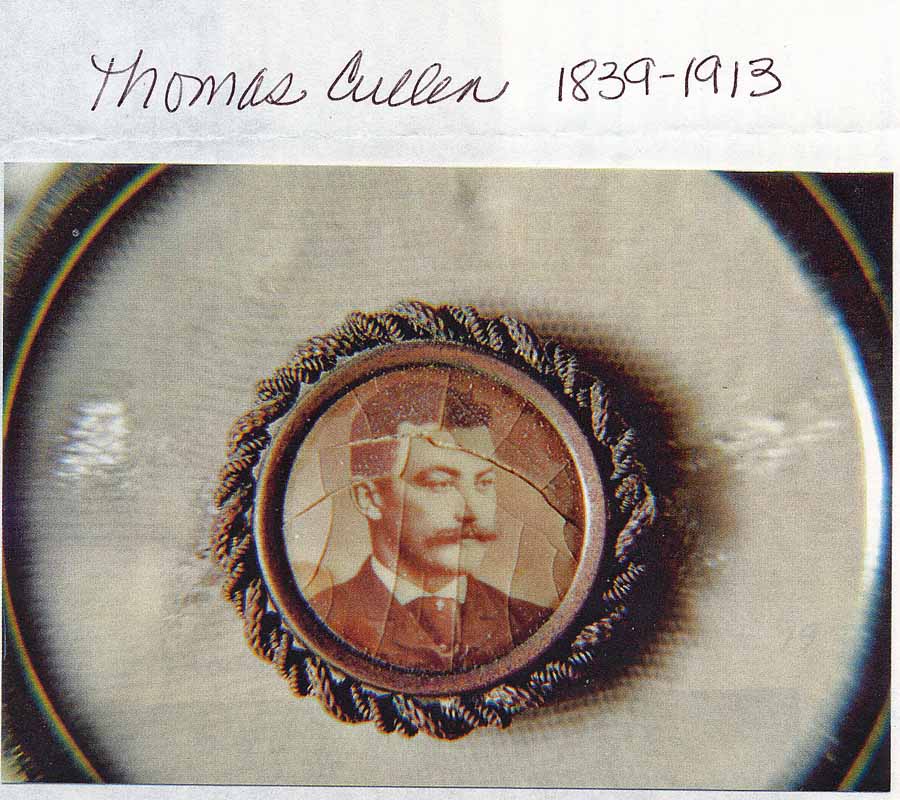|
|
Post by groundhog on Sept 13, 2012 23:16:45 GMT
John Laverty
Callao Bay, Peru
14th September 1881  USS Alaska USS AlaskaJohn Laverty is recorded as being born in Dublin in 1849. In 1881 he was a First Class Fireman in the US Navy, serving aboard the USS Alaska. The Alaska was a wooden hulled sloop built in 1868. She had been stationed in the Pacific since 1878. On 14th September 1881 she was in Callao Bay, Peru when stop-valve chamber ruptured causing flames to erupt from underneath the boilers. Laverty and a Fireman called Barrett hauled the fires from under the boiler thus saving the ship and they were both awarded a Medal of Honor on 18th October 1884. Now the mystery. As you can see John Laverty is credited with Two Medals of Honor. As John Lafferty he had earned a Medal of Honor during the Civil War. Citation below; On May 25, 1864, a daring plan was laid in an effort to destroy the rebel ram Albermarle which was afloat on the Roanoke River in North Carolina. Fireman John Lafferty was among the volunteers who transferred two torpedoes with a weighted line across an island swamp and then was detailed to guard their clothes and arms. While trying to place the torpedoes the men were discovered and challenged by a sentry, forcing them to abandon their plan under the fire of enemy rifles, and seek shelter. Fireman Lafferty, despite the danger once the plan was discovered, remained guarding the clothes and arms until rejoined by his party, and rejoined his ship after 24 hours avoiding enemy patrols in the rain and the swamp.The only problem is that Lafferty is recorded as being born in New York in 1842. For the purposes of this thread we will say that 19th Century US Navy record keeping was below par and that John Laverty/Lafferty from Dublin did indeed win the MOH on two separate occasions. John Laverty died in Philadelphia on November 13th 1903 aged 61 and is buried in Mount Moriah Cemetery. |
|
|
|
Post by groundhog on Sept 17, 2012 0:05:22 GMT
Battle of Antietam
17th September 1862
Richard Curran A brief account of the battle here; stmhs.proboards.com/index.cgi?board=general&action=display&thread=12#ixzz26eQzGwDxRichard Curran was born in Ennis, Co. Clare on 4th January 1838. He emigrated to the US with his family in 1850 and studied medicine at Harvard. He joined the US Army at the start of the Civil War. By 1862 he was Assistant Surgeon, 33rd New York Infantry. He won his Medal of Honor at the Battle of Antietam on 17th September 1862. His Citation reads that he “Voluntarily exposed himself to great danger by going to the fighting line there succoring the wounded and helpless and conducting them to the field hospital” The 33rd New York were located east of Dunker Church. Richard Curran rose to the rank of Major. After the War he opened up a drug store in Rochester, New York where he later served as mayor. His medal was issued in 1898. Curran died on June 1st 1915 and is buried in Holy Sepulchre Cemetery, Rochester. John Murphy John Murphy was born June 24th 1844 in Killarney. Murphy was a Private in Company K, 5th Ohio Infantry at Antietam. He also fought at Dunker Church where he captured the flag of the 13th Alabama Infantry. His medal was issued on 11th September 1866. He died 1st January 1911 in Cincinatti, Ohio and is buried in Spring Grove Cemetery. |
|
|
|
Post by groundhog on Sept 18, 2012 23:03:37 GMT
Third Battle of Winchester
19th September 1864
Patrick McEnroe An account of the Third Battle of Winchester here; www.civilwar.org/battlefields/thirdwinchester/third-winchester-history-articles/winchesteradelman.htmlwww.civilwar.org/battlefields/thirdwinchester/maps/thirdwinchestermap.htmlPatrick McEnroe was a Sergeant in Company D, 6th New York Cavalry when he won his MOH at Winchester on 19th September 1864. His medal was earned for the capture of the colours of the 36th Virginia Infantry . The 6th New York Cavalry was in Devin’s Bde of Merriitt’s Second Cavalry Division which attacked the Confederate left flank. (see map) George Reynolds  Reynolds in 1886 George Reynolds was a Private in Company M, 9th New York Cavalry at Winchester. His medal was awarded for the capture of the Virginia State flag. The 9th New York Cavalry was also in Devin’s Bde of Merriitt’s Second Cavalry Division. This article apparently refers to the same George Reynolds en.wikipedia.org/wiki/Art_Students'_League_of_Philadelphia Peter Ryan Peter Ryan was a Private in Company D, 11th Indiana Infantry. He and another man captured 14 Confederate soldiers and were awarded a MOH. The 11th Indiana were in 2nd Bde, 2nd Div of Emory’s XIX Corps. Peter Ryan was born in Co. Tipperary in 1841 or 1845. He died on January 8th 1908 age 65 and is buried in Calvary Cemetery, Terre Haute, Indiana. His age at death indicates a birth year of 1842. |
|
|
|
Post by groundhog on Sept 21, 2012 23:23:13 GMT
Battle of Fisher’s Hill
21st-22nd September 1864 Jubal Early’s army driven back from Winchester took up a strong defensive position at Fisher’s Hill, south of Strasburg, Virginia. On September 21, the Union army advanced, driving back skirmishers and capturing high ground. On the 22nd, Crook’s Corps moved along North Mountain to outflank Early on his left flank, attacking about 4 pm. The Confederate cavalry offered little resistance, and the infantry were taken by surprise and were unable to redeploy to face the attacking force. The Confederate defence collapsed from west to east as Sheridan’s other corps join in the assault. Early retreated to Rockfish Gap near Waynesboro, opening the Shenandoah Valley to a Union invasion. James Connors James Connors was born in Kildare in 1838. At Fishers Hill he was a Private in Company E, 43rd New York Infantry. He earned his MOH for capturing a Confederate Flag, the medal being issued on 6th October 1864. Connors date and place of death are unknown. His home was at Canajoharie, New Jersey so it’s possible he ended his life there. John Creed John Creed was born in Tipperary in 1819. He joined the 23 rd Illinois Infantry in August 1862 and was a Private in Company D at Fishers Hill. His citation was also for the capture of a flag and like Connors his medal was issued on 6th October 1864. Creed was later promoted to Corporal. He was discharged in June 1865. He died on November 28th 1872 in Evanston, Illinois and is buried in Calvary Cemetery. |
|
|
|
Post by groundhog on Sept 27, 2012 23:01:11 GMT
William McCabe
Palo Duro Canyon, Texas
28th September 1874 William McCabe was born in Belfast in 1848. He emigrated to Mexico and, during the French occupation of that country he served in the republican army. After the fall of Emperor Maximilian, McCabe moved to the United States and by 1871 he was employed by the Army as a civilian scout based at Fort Duncan, Texas. With his experience in Mexico, McCabe had Mexican contacts, spoke Spanish, and was familiar with the geography of Northern Mexico. His scouting duties involved keeping tabs on trans-border crime, Mexican revolutionaries, and Indian movements. For some reason on February 3rd 1874 he enlisted as a Private in the 4th Cavalry still at Fort Duncan. In 1874 the US Army was engaged in a short campaign, called the Red River War, against the Southern Plains Indians- the Kiowa, Commanche, Southern Cheyenne and Arapaho. The campaign was fought in the Texas Panhandle in an effort to remove several thousand Indians to reservations in present-day Oklahoma. The 4th Cavalry formed one of five columns that converged on the area, under command of Col. MacKenzie. One of the battles fought during the campaign was at Palo Duro Canyon. Camped in the canyon and spread out over a wide area, was a large band of Commanche, Kiowa and Cheyenne. The column scouts located the Indian camp and early on the morning of September 28th the Cavalry rode into the canyon, attacking the Kiowa camp of Lone Wolf first. The Indian warriors fought a rear guard action while the women and children fled. Within a short time all the Indians had been driven from the canyon. Strangely the fatalities for this engagement were one soldier and four Indians killed. Yet the battle was decisive for MacKenzie’s men had captured all the food the Indian bands had been storing for winter along with 1,400 horses. The horses were slaughtered at nearby Tule Canyon. With no food and no horses the Indian bands surrendered over the course of the winter and spring. McCabe left the Army on May 30, 1875, due to a disability incurred on service. He served as a civilian guide for the quartermaster of Fort Brown, Texas, where he received his Medal of Honor on January 28th, 1876. The last account of McCabe was in Eagle Pass, Texas, in December 1881. It is not known when he died. A memorial marker, honouring McCabe was placed at Fort Concho National Historic Landmark in San Angelo, Texas. More on the Red River War; www.thc.state.tx.us/publications/brochures/rrw_gd_10.pdf |
|
|
|
Post by groundhog on Sept 28, 2012 23:08:32 GMT
Richard Gasson
Chapins Farm, Virginia
29th September 1864 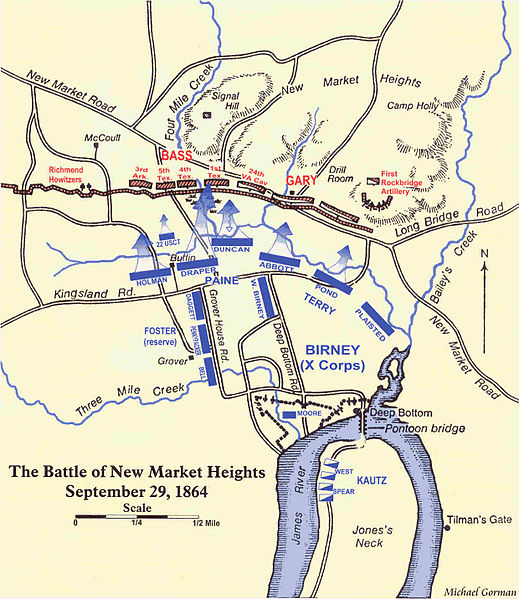 From the beginning of the Civil War, the Confederates built permanent defences around Richmond, Virginia. By 1864, they had created an outer system of forts anchored south of the capital on the James River at Chaffin's Farm. There was an intermediate and inner system of fortifications closer to the capital. The battle of Chaffin’s Farm was part of an attempt by General Ulysses S. Grant to capture Richmond, attacking simultaneously north and south of the James river. The attack north of the river occurred on September 29 commanded by General Benjamin Butler and capturing New Market Heights in the early morning. Other elements of Butler's forces then overwhelmed the Confederate defenders inside Fort Harrison. However, uncoordinated attacks against Forts Gilmer, Gregg and Johnson all failed. A Confederate counterattack on September 30 proved equally futile, and the two armies settled into trench warfare that continued until the end of the war. The fighting around Chaffin's Farm cost nearly 5,000 casualties, one of the fatalities being Sgt Richard Gasson of Company K, 47th New York Infantry. Sgt Gasson fell dead while planting the colors of his regiment on the Confederate ramparts at Chapin’s Farm. On the map below you can see the location of his Brigade- Pennypacker’s in Foster’s Division. Gasson’s burial place appears to be unknown. Many of the dead of this area were brought into Fort Harrison National Cemetery after the war and most of the burials there are unknown soldiers. Gasson is probably one of them. His medal was issued on 6th April 1865. You’ll have noted the variety in spelling the Placename. Chaffin’s Farm appears to be correct but the US Army has recorded it as Chapin’s Farm. The battle is also referred to as New Market Heights and Laurel Hill. Samuel Horne
Fort Harrison, Virginia
29th September 1864 Samuel Horne was a Captain in Company H, 11th Connecticut Infantry. He was born on 3rd March 1843 in Beleek, Co. Fermanagh and joined the army at Winsted, Connecticut. His citation reads that “while acting as an aide and carrying an important message, he was severely wounded and his horse killed but he delivered the order and rejoined his general.” In common with many MOH recipients he had to wait many years, until 19th November 1897, for his medal. He lived long to enjoy it however, dying on 18th September 1928, aged 85 in Winsted. The attack on Fort Harrison was a continuation of the earlier attack on Chaffin’s Farm |
|
|
|
Post by groundhog on Sept 28, 2012 23:42:21 GMT
Red River, Texas
29th September 1872 We’re back in the Texas Panhandle again where William McCabe would win his MOH almost two years to the date after these events. Colonel MacKenzie commanded an expedition on the Staked Plains to find and rout hostile Indians. The 4th Cavalry made a one-day march to the North Fork of the Red River, where a large Comanche camp of 280 lodges was sighted. As the cavalry moved towards the encampment, the Indian ponies stampeded and alerted the Indians to the soldiers' approach. Immediately they engaged the cavalry in a fire fight. One Company of Cavalry advanced to secure the right flank while the remaining companies attacked the left. The camp was taken with the loss of only one soldier killed and three wounded. The Comanche band subsequently surrendered at Fort Sill, modern-day Oklahoma. David Larkin Born in Ireland in 1845, Larkin served as a Farrier in Company F, 4th U.S. Cavalry. His MOH was isued on 19th November 1872. Larkin died on May 8th 1905 in Arlington, Massachusetts where he is buried in St. Paul’s Cemetery. William McNamara William McNamara was born in Co. Cork in 1835. In 1872 he was First Sergeant, Company F, 4th U.S. Cavalry. His Citation for his MOH was for Gallantry in action. He died 16th March 1912 in New York. He is buried in Calvary Cemetery, Queens. Edward Branagan Edward Branagan was born in 1846 in Co. Louth. He was a Private in Company F, 4th U.S. Cavalry when he won the MOH at Red River for “Gallantry in action”. His date of death is unknown but he is buried in San Angelo, Texas so he may not have lived to great old age. |
|
|
|
Post by groundhog on Sept 30, 2012 20:32:17 GMT
Bear Paw Mountain, Montana
30th September 1877  Map of the battlefield. After the Big Hole Battle in early August (see post #2 in this thread) the Nez Perce Indians continued across Montana in an effort to reach Canada and escape the US Army. There were a couple of engagements along the route but for our purposes we’ll look at the Battle of Bear Paw Mountain on 30th September 1877 where an Irishmean won the Medal of Honor. Col Nelson Miles and a force of 520 or so men from the 2nd and 7th Cavalry Regiments, as well as mounted infantrymen of the 5th Infantry Regiment, had left Fort Keogh on September 18th in pursuit of the Cheyenne. His scouts picked up the Indians trail on September 29th after a fall of snow and their encampment was discovered on Snake Creek north of the Bear Paw Mountains. Miles decided to attack the camp next morning, fearing that the Indians would escape to Canada. The Nez perce meanwhile believed there were no soldiers in the area and were in no hurry to break camp. Miles plan was simple, to charge in three lines into the camp with 160 men of the 2nd Cavalry plus his Indian Scouts in the first line, the 110 men of the 7th Cavalry in the second and the 5th Infantry in reserve. Unfortunately his plan fell apart early on because before the camp was reached, the first line veered away to capture the Indian horses. The Indians meanwhile had split up, most of the warriors taking cover in a ravine near their camp while the women and children protected by some warriors lit out for the border. Some of the 2nd Cavalry went off in pursuit but were driven back by the Indians. Meanwhile back at Snake Creek, the 7th Cavalry charged on to the camp but were ambushed by the Indians in the ravine, sustaining some casualties.. With the Indians in cover, Miles brought up the mounted Infantry and set up a firing line, surrounding the Indians. The 7th Cavalry and some mounted Infantry attempted a charge of the Nez Perce position but were beaten back with some losses. By now it was near nightfall and both sides settled down for the night. That was basically the Battle of Bear Paw Mountain. The army besieged the Indians until they surrendered on October 5th. The battle had cost the Nex Perce 23 men and 2 women killed, 46 wounded and 431 captured. The army lost 24 dead 49 wounded. The captured Nez Perce were sent to reservations in Oklahoma but were later allowed to Washington State. Chief Joseph, the man who led his people on a 1100 mile march across the US pursued by the army died on Colville Reservation in Washington State in September 1904. Henry Hogan  Henry Hogan was born March 8th, 1840 in Co. Clare. By 1877 he was a First Sergeant in Company G, 5th U.S. Infantry. During the attack on the Nez Perce camp he carried Lt. Romeyn, who was severely wounded, to cover under heavy fire, for which he was awarded a MOH. This award was Hogan’s second Medal of Honor award, making him one of only 19 men, five of them Irish, to be so honoured. His first award was for gallantry in action at Cedar Creek and subsequent actions between October 1876 and 8th January 1877. Henry Hogan died on 20th April 1916 in Montana and is buried in Custer County Cemetery, Miles City. |
|
|
|
Post by groundhog on Oct 1, 2012 10:04:09 GMT
Robert Wright
Chapel House, Farm, Virginia
1st October 1864 Robert Wright was born in Ireland in 1828. He joined the US Army in Woodstock, Connecticut and served in Company G, 14th Infantry Regiment. He won a Meda lof Honor in action against Confederate forces at Chapel House Farm, Virginia, on October 1 1864 for gallantry in action. His medal was issued on the 25th November 1869. Robert Wright died 22nd October 1885 and is buried in Cedar Lawn Cemetery, Paterson, New Jersey. Photo Credit www.homeofheroes.com |
|
|
|
Post by groundhog on Oct 1, 2012 10:13:50 GMT
Thomas Smith
USS Enterprise, off Para, Brazil
1st October 1878 Thomas Smith was born in Ireland in 1856. He joined the Navy in Virginia. On 1st October 1878 he was a Seaman aboard the USS Enterprise, off the coast of Brazil when he rescued from drowning William Kent, coxswain of the Enterprise. He was awarded a Medal of Honor for this act. Smith’s date of death and burial location are unknown. Photo Credit www.history.navy.mil/
|
|
|
|
Post by groundhog on Oct 1, 2012 10:40:09 GMT
Joseph Thompson
Apremont, France
1st October 1918 Joe Thompson was born on 26th September 1871 in Kilkeel, County Down. He emigrated to the US in 1898 and studied law at the Western University of Pennsylvania where he also played football. After graduation he coached the team before going on to practice law in Beaver Falls, Pennsylvania. He also sat in the State Senate from 1913 to 1916. When the US declared war on Germany in 1917 Thompson joined the Army fighting in Mexico and France. On 1st October 1918 he was a Major in the 110th Infantry Regiment, 28th Division near Apremont, France. When his unit was attacked by two regiments of Germans Thompson; “encouraged his battalion in the front line of constantly braving the hazardous fire of machineguns and artillery. His courage was mainly responsible for the heavy repulse of the enemy. Later in the action, when the advance of his assaulting companies was held up by fire from a hostile machinegun nest and all but 1 of the 6 assaulting tanks were disabled, Maj. Thompson, with great gallantry and coolness, rushed forward on foot 3 separate times in advance of the assaulting line, under heavy machinegun and antitank-gun fire, and led the 1 remaining tank to within a few yards of the enemy machinegun nest, which succeeded in reducing it, thereby making it possible for the infantry to advance”For this action Joe Thompson was awarded a Medal of Honor. He was the last Irish born recipient of the medal and the only Irishman to earn one in World War 1. He also won the Distinguished Service Medal and was awarded the French Croix de Guerre and a British decoration. After the war Joe practiced law in Beaver Falls, Pennsylvania until he died in 1928 as a consequence of his war wounds. He is buried in Beaver Falls Cemetery. Photo Credits www.findagrave.com/ |
|
|
|
Post by groundhog on Oct 3, 2012 22:16:21 GMT
Denis Murphy
Corinth, Mississippi
3rd October 1862 [/b] Denis Murphy was born in Co. Cork on June 28th 1830. His family emigrated to the US and before the war Murphy and his wife farmed in Wisconsin. He joined the 14th Wisconsin Infantry in September 1861 and was wounded at Shiloh. By October 1862 he was a Sergeant at the Second Battle of Corinth in Mississippi. Though wounded three times during the fighting, Denis carried the Union Colours through the battle. He paid a heavy price as his wounds disabled him for life. He was discharged from the army in November 1862, having been commissioned a Lieutenant. He was awarded a Medal of Honor on 22nd January 1892. Denis and his family lived in Green Bay, Wisconsin after the war. He died there on 19th June 1901 and is buried in Allouez Cemetery. More detail here; irishamericancivilwar.com/2011/01/31/medal-of-honor-sergeant-dennis-j-f-murphy-14th-wisconsin-infantry/Photo Credit; image2.findagrave.com/ |
|
|
|
Post by groundhog on Oct 4, 2012 23:10:09 GMT
Daniel Keating
Witchita River, Texas
5th October 1870 Daniel Keating was born in Co. Cork in 1846. On 5th October 1870 he was a Corporal in Company M, 6th US Cavalry. A few days earlier a Captain Rafferty had led a twenty-two man patrol from Fort Richardson to find and defeat a marauding force of Indians. The Indians were Kiowa who had left their reservation in Oklahoma and crossed into their old stomping grounds in Texas to raid and pillage. The US soldiers had been skirmishing and chasing them all summer. Guided by a civilian scout- James Dozier the soldiers picked up the trail of the Kiowa and followed it to the Little Wichita River, reaching their camp on the morning of October 5th. The cavalrymen attacked the war party. In addition to the Indians killed, eighteen horses were captured along with many supplies. Corporal Daniel Keating was one of five enlisted men cited for "Gallantry during the pursuit and fight with Indians" at the Little Wichita River. Civilian Scout Dozier, who was in large measure responsible for the success of this expedition, was also awarded the Medal of Honor. Daniel Keating died on 20th June 1912 and is buried in Holy Cross Cemetery, Malden, Massachusetts. Photo Credit; www.waymarking.com/ |
|
|
|
Post by groundhog on Oct 12, 2012 8:48:03 GMT
Michael Dougherty
Jefferson, Virginia
12th October 1863 Michael Dougherty was born in Falcarragh, Co. Donegal on May 10th 1844. He immigrated to America with his family at the age of 15 and worked in a Philadelphia hotel. In August 1862 he joined the 13th Pennsylvania Cavalry and fought at Antietam. On 26th February 1863, he and 50 of his comrades were taken prisoner during an ambush in the Shenandoah Valley. After three months captivity they were exchanged for Confederate prisoners. Dougherty distinguished himself as a dispatch rider at the Battle of Winchester in June 1863 for which he was decorated for bravery. On 12th October 1863 Dougherty, presumably a sentry, spotted a detachment of Confederate Cavalry riding through Union lines. Dougherty roused his comrades and, opening fire on the enemy, they drove them to take cover in a nearby house. The Donegal man then led a detachment of his company across an open field, exposed to enemy fire and succeeded in dislodging the Confeerates from the house. The men then held this position for several hours against repeated attacks, preventing the Confederates from flanking the Union forces. Late in the afternoon, their ammunition expended, Dougherty and his comrades were forced to surrender. There was no exchange this time and he spent almost two years in Southern Prison Camps including Andersonville, Georgia. Of the 127 men who surrendered with him at Jefferson, only Michael Dougherty survived captivity. However his trials were not over. Having left Andersonville on 12th April 1865 he was among 4,000 former prisoners who, boarded two ships at Vicksburg on the Mississippi on April 22nd bound for St. Louis. On the night of the 27th, a boiler on Dougherty’s ship burst and set the ship ablaze. Over 1500 men died in the disaster, Dougherty swam ashore. He finally made it back to Bristol Pennsylvania where he lived out his days, in peace I hope. He married a lady named Rose Magee and they had nine children. He worked in the U.S. Mint in Philadelphia, and became a city councilman. His Medal of Honor was one of those that took years to be awarded, he was issued it on 23rd January 1897. Michael lived on to the age of 86, dying on 19th February 1930. He is buried in Saint Marks Roman Catholic Churchyard in Bristol, Pennsylvania. Photo Credits irishamerica.com/
|
|
|
|
Post by groundhog on Oct 13, 2012 23:08:46 GMT
Bristoe Station, Virginia
14th October 1863 After the Battle of Gettysburg, Lee led his Confederate army south and concentrated it south of the Rapidan River in Virginia. The Union Army advanced in August to the Rapahannock River and then in September advanced to confront Lee’s forces. Both sides meanwhile had been forced to send troops to Georgia to reinforce their respective forces after the Battle of Chickamauga. In early October, Lee advanced with two Corps around Meade's right flank, potentially advancing on Washington and forcing the Federals to withdraw north along the line of the Orange & Alexandria Railroad. On October 14th Hill’s corps stumbled upon two corps of the retreating Union army at Bristoe Station and attacked without proper reconnaissance. The Union II Corps, located behind a railroad embankment, made a successful defence of their position and inflicted heavy casualties on Hill’s Corps. After the battle, the Federals continued their withdrawal to Centreville unmolested. Lee’s Bristoe offensive sputtered to a premature halt and after minor skirmishing near Manassas and Centreville, the Confederates retired slowly to the Rappahannock River destroying the railway as they went. Bristoe Station put a significant dent in Hill’s reputation and Lee appears to have blamed him for the failure of the Bristoe Campaign. In the Second Division of II Corps at Bristoe Station was the 82nd New York Infantry commanded by Major Thomas Baird. Two Irish-born members of this unit won Medals of Honour on the day. Map Credit; www.civilwar.org/ Thomas Cullen Thomas Cullen was a Corporal in Company I. He was born in Ireland on 26th February 1839 and joined the Army in New York. His medal was issued on 1st December 1864 for the capture of the flag of a North Carolina Regiment during close-quarter fighting. Thomas died in Kinny, Pennsylvania on 17th August 1913 and is buried in St. Mary’s Cemetery. Photo Credit; Patricia B, www.findagrave.com/ Emmett Urell Michael Emmett Urell was a Private in Company E of the 82nd New York at Bristoe Station. His citation was for gallantry in action while detailed as a colour bearer. During the fighting he was severely wounded. Urell was born in Ireland on on November 8th 1844.Depending on which source you use he was born in Nenagh or Cork. To confuse the issue there appear to have been two Michael Urells, who were cousins, in the army at the same time. This also led to confusion about his rank at Bristoe Station (Private or Lieutenant, the US Army says Private). Our Emmett Urell died on September 6th 1910 while on a trip home to Ireland and was originally buried in Cork. He was subsequently reinterred in Arlington National Cemetery. Urell served on in the army after the Civil War and was commissioned because he held the rank of Major at the time of his death. Photo Credit; www.homeofheroes.com/ |
|




